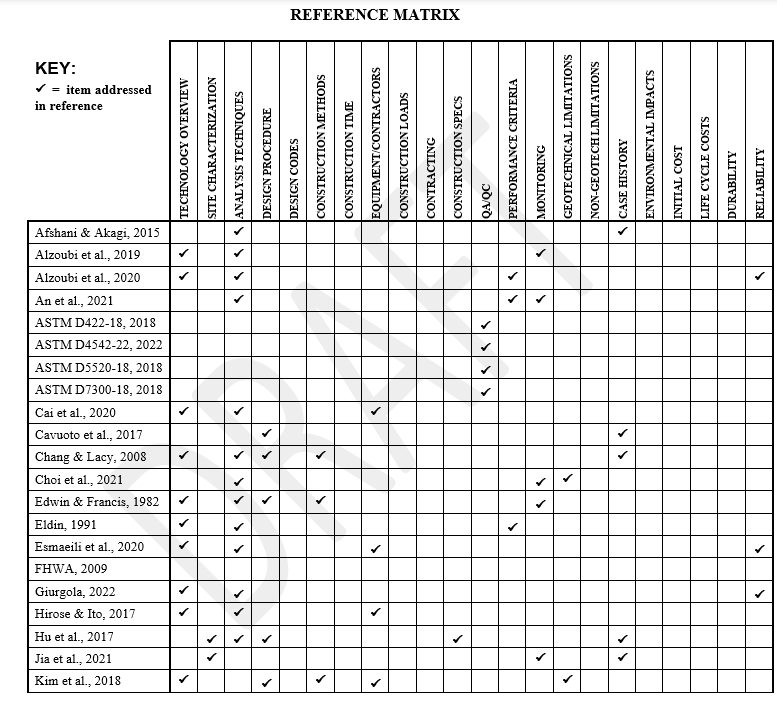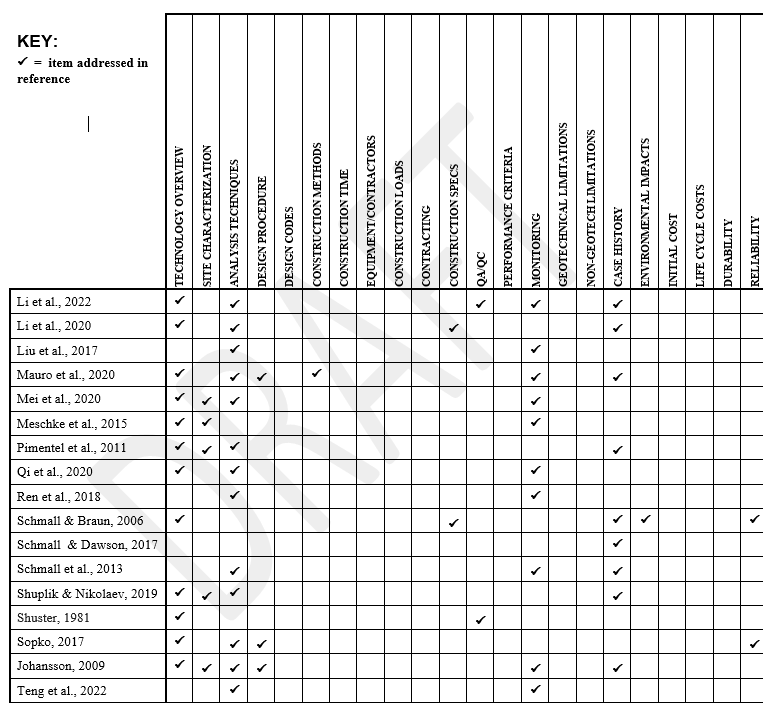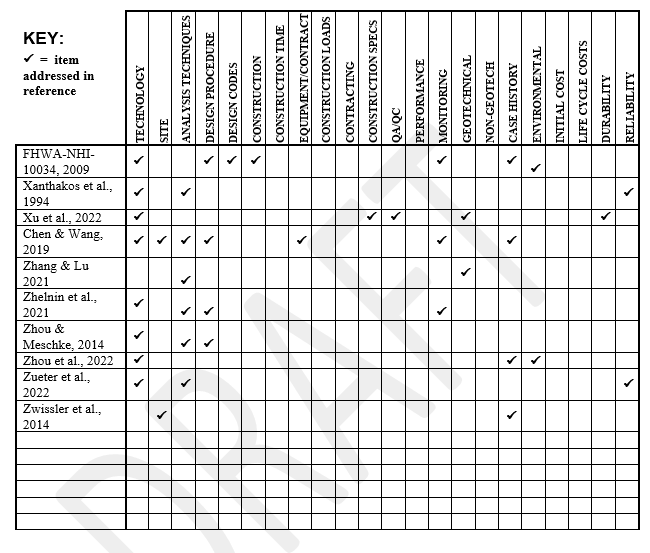References
Afshani, A., & Akagi, H. (2015). Artificial ground freezing application in shield tunneling. Japanese Geotechnical Society Special Publication, 3(2), 71-75.
Alzoubi, M. A., Sasmito, A. P., Madiseh, A., & Hassani, F. P. (2019). Freezing on demand (FOD): an energy saving technique for artificial ground freezing. Energy Procedia, 158, 4992-4997.
Alzoubi, M. A., Xu, M., Hassani, F. P., Poncet, S., & Sasmito, A. P. (2020). Artificial ground freezing: A review of thermal and hydraulic aspects. Tunnelling and Underground Space Technology, 104, 103534.
An, R., Zhang, X., Kong, L., Gong, J., & Lei, X. (2021). Artificial ground freezing impact on shear strength and microstructure of granite residual soil under an extremely low temperature. Frontiers in Earth Science, 935.
ASTM D422-18 (2018). Standard Test Method for Particle Size Analysis of Soils, ASTM International, West Conshohocken, PA.
ASTM D4542-22 (2022). Standard Test Methods for Pore Water Extraction and Determination of the Soluble Salt Content of Soils by Refractometer, ASTM International, West Conshohocken, PA.
ASTM D5520-18 (2018). Standard Test Method for Laboratory Determination of Creep Properties of Frozen Soil Samples by Uniaxial Compression, ASTM International, West Conshohocken, PA.
ASTM D7300-18 (2018). Standard Test Method for Laboratory Determination of Strength Properties of Frozen Soil at a Constant Rate of Strain, ASTM International, West Conshohocken, PA.
Cai, H., Li, P., & Wu, Z. (2020). Model test of liquid nitrogen freezing-temperature field of improved plastic freezing pipe. Journal of Cold Regions Engineering, 34(1), 04020001.
Cavuoto, F., Marotta, P., Massarotti, N., Mauro, A., & Normino, G. (2017). Artificial ground freezing: heat and mass transfer phenomena. In Proceedings of CHT-17 ICHMT International Symposium on Advances in Computational Heat Transfer. Begel House Inc.
Chang, D. K., & Lacy, H. S. (2008). Artificial ground freezing in geotechnical engineering. International Conference on Case Histories in Geotechnical Engineering, Arlington, VA, August 11-16, 2008.
Choi, H. J., Won, J., Lee, D., Lee, H., & Choi, H. (2021). Effect of ground freezing with liquid nitrogen on freezing rate and mechanical properties of coastal clayey silt. Journal of Engineering Mechanics, 147(9), 04021057.
Edwin, J. C., & Francis, H. S. (1982). Ground Freezing, Proceedings of The 3rd International Symposium on Ground Freezing. 22-24 June 1982 U.S. Army Corps of Engineers Cold Regions Research and Engineering Laboratory, Hanover, New Hampshire.
Eldin, N. N. (1991). Effect of artificial salting on freezing behavior of silt soil. Journal of Cold Regions Engineering, 5(4), 143-157.
Esmaeili-Falak, M., Katebi, H., & Javadi, A. A. (2020). Effect of freezing on stress-strain characteristics of granular and cohesive soils. Journal of Cold Regions Engineering, 34(2), 1-18.
FHWA (2009). US Department of Transportation Federal Highway Administration, “Technical Manual for Design and Construction of Road Tunnels-Civil Elements”, Report No. FHWA-NHI-10034.
Gao, W., Han, Y., Wu, T., & Ma, W. (2022). Comprehensive review of artificial ground freezing applications to urban tunnel and underground space engineering in China in the last 20 years. Journal of Cold Regions Engineering, 36(3), 04022002.
Giurgola, B. (2022). Ground Freezing & Jet Grouting. A Hybrid Solution for Tunneling in Urban Environments. World Tunnel Congress 2022, Copenhagen Sept 2-8, 2022.
Hirose, G., & Ito, Y. (2017). Experimental estimation of permeability of freeze-thawed soils in artificial ground freezing. Procedia Engineering, 189, 332-337.
Hu, J., Liu, Y., Wei, H., Yao, K., & Wang, W. (2017). Finite-element analysis of heat transfer of horizontal ground-freezing method in shield-driven tunneling. International Journal of Geomechanics, 17(10), 04017080.
Jia, D., Liu, M., Li, K., Wang, X., Wang, Z., Wen, J., & Lai, X. (2021). Variations in the top-layer soil freezing/thawing process from 2009 to 2018 in the Maqu area of the Tibetan Plateau. Theoretical and Applied Climatology, 143(1), 21-32.
Johansson, T. (2009). Artificial ground freezing in clayey soils: laboratory and field studies of deformations during thawing at the Bothnia line, Doctoral dissertation, KTH, Stockholm, Sweden.
Keller, North America. (2022). Ground Freezing Design Calculations, 31.54.00 1.07 C.2, NYC DEP Shaft 18B-1, City Tunnel No.3 Stage 2, Long Island City, New York.
Kim, Y., Hwang, B., & Cho, W. (2018). Development of ground freezing system for undisturbed sampling of granular soils. Advances in Civil Engineering, 2018, Article ID 1541747, p. 13.
Li, P. T., Li, D. Q., Tang, X. S., & Liu, Y. (2022). Hydrothermal performance of in-tunnel ground freezing subjected to drilling inaccuracy and seepage flow. ASCE-ASME Journal of Risk and Uncertainty in Engineering Systems, Part A: Civil Engineering, 8(1), 04021071.
Li, Z., Chen, J., Sugimoto, M., & Mao, C. (2020). Thermal behavior in cross-passage construction during artificial ground freezing: case of Harbin metro line. Journal of Cold Regions Engineering, 34(3), 05020002.
Liu, Y., Hu, J., Xiao, H., & Chen, E. J. (2017). Effects of material and drilling uncertainties on artificial ground freezing of cement-admixed soils. Canadian Geotechnical Journal, 54(12), 1659-1671.
Mauro, A., Normino, G., Cavuoto, F., Marotta, P., & Massarotti, N. (2020). Modeling artificial ground freezing for construction of two tunnels of a metro station in Napoli (Italy). Energies, 13(5), 1272.
Mei, Y., Zhao, L., Wang, X., Zhou, D., Yang, T., Liu, Y., & Gong, H. (2020). Field test study of the artificial ground-freezing method subsurface excavation construction of watered sandy stratum in collapsible loess area. Advances in Civil Engineering, 2020, Article ID 6665372, p. 14.
Meschke, G., Zhou, M. M., Abd Elrehim, M. Z., & Marwan, A. (2014). Computational modelling and optimization of artificial ground freezing in tunneling. In Computer Methods and Recent Advances in Geomechanics–Proceedings of the 14th Int. Conference of International Association for Computer Methods and Recent Advances in Geomechanics, IACMAG, 1397-1402.
Pimentel, E., Papakonstantinou, S., & Anagnostou, G. (2011). Case studies of artificial ground freezing simulations for urban tunnels. Proc. WTC 2011 Underground Spaces in the Service of Sustainable Society and & 37th ITA-AITES General Assembly. Helsinki, Finland – 05-10 May 2011
Qi, Y., Zhang, J., Yang, H., & Song, Y. (2020). Application of artificial ground freezing technology in modern urban underground engineering. Advances in Materials Science and Engineering, 2020, Article ID 1619721, p. 12.
Ren, J., Vanapalli, S. K., & Han, Z. (2018). Soil freezing process and different expressions for the soil-freezing characteristic curve. Sciences in Cold and Arid Regions, 9(3), 221-228.
Schmall, P. C., & Braun, B. (2006). Ground freezing—a viable and versatile construction technique. In Proceedings of the International Conference on Cold Regions Engineering, pp. 1-11.
Schmall, P., & Dawson, A. (2017). Ground-freezing experience on the east side access Northern Boulevard crossing, New York. Proceedings of the Institution of Civil Engineers-Ground Improvement, 170(3), 159-172.
Schmall, P., Madsen, P. H., & Pepe, F. (2013). Ground freezing for the east side access northern boulevard crossing–balancing settlement and heave control. In Proceedings from the 2013 Rapid Excavation and Tunneling Conference, pp. 439-448.
Shuplik, M., & Nikolaev, P. (2019). Advanced ground freezing method and its applications in underground construction. In MATEC Web of Conferences (Vol. 265, p. 04021). EDP Sciences.
Shuster J. A. (1981). Engineering quality assurance for construction ground freezing. Engineering Geology. 18(1-4): 333-50.
Sopko, J. A. (2017). Coupled heat transfer and groundwater flow models for ground freezing design and analysis in construction. In Geotechnical Frontiers 2017. 719-729.
Sopko, J. A. (2023). Ground Freezing for Deep Shaft Excavation, Shaft 17B-1, New York City Water Tunnel No. 3, New York.
Teng, Y. C., Teng, Z. C., Liu, Y., Liu, X. Y., Zhou, Y. D., Liu, J. L., & Li, B. (2022). A review of the research on thermo-hydro-mechanical coupling for the frozen soil. Geofluids, 2022.
Xanthakos, P. P., Abramson, L. W., & Bruce, D. A. (1994). Ground control and improvement. John Wiley & Sons.
Xu, P., Han, S., & Xing, Y. (2022). Analysis of Influencing Factors of Temperature Field in Freezing Construction of Metro Connecting Passage. Geotechnical and Geological Engineering, 40(3), 1331-1343.
Yung Chen, Ting-Wei Wang. (2019). Artificial Ground Freezing to Form Walls in Taiwan, Deep Foundations, July/Aug 2022.
Zhang, C., & Lu, N. (2021). Soil sorptive potential–based paradigm for soil freezing curves. Journal of Geotechnical and Geoenvironmental Engineering, 147(9), 04021086.
Zhelnin, M. S., Kostina, A. A., Plekhov, O. A., & Levin, L. Y. (2021). Numerical simulation of vertical shaft sinking using artificial ground freezing. In E3S Web of Conferences (Vol. 266, p. 03008). EDP Sciences.
Zhou, X. M., Jiang, G., Li, F., Zhou, M. M., & Meschke, G. (2014). Numerical modeling of artificial ground freezing: multiphase modeling and strength upscaling. Ground improvement and geosynthetics. American Society of Civil Engineers, Reston, VA, 209-219.
Zueter, A. F., Madiseh, A. G., Hassani, F. P., & Sasmito, A. P. (2022). Effect of freeze pipe eccentricity in selective artificial ground freezing applications. Journal of Thermal Science and Engineering Applications, 14(1).
Zwissler, B., Oommen, T., & Vitton, S. (2014). A study of the impacts of freeze–thaw on cliff recession at the Calvert Cliffs in Calvert County, Maryland. Geotechnical and Geological Engineering, 32(4), 1133-1148.



